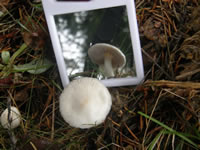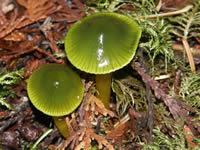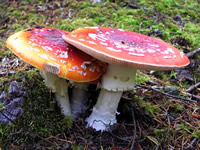|
| | |
Along the Mushroom Trails - Understanding Mushrooms Page 2 |
| | |
 |
When the gills are notched and are barely attached to the stem, it is called "adnexed." |
| | |
 |
Short gills are called Lamellulae. These are the gills that do not extend all the way to the stem as shown here on this White Fibrecap, Inocybe geophylla. This can be a useful feature in correct identification. |
| | |
This polypore mushroom shows pores instead of gills on the underside of the cap.
These pores resemble small holes but are actually the ends of a series of tube-like structures which produce spores.
Eventually the spores are released into the wind for dispersal.
|
 |
| | |
|
|
Bolete mushrooms have fleshy pores unlike the hard pores of Polypore mushrooms.
In this group of mushrooms the stipe is also mostly central. |
| | |
 |
A third method of spore dispersal is used by a group of mushrooms called Teeth Fungi which have long, thin teeth (sometimes called spines) which hang down from the underside of the cap. Like the gills of gilled mushrooms, spores are produced in these spiny, hanging teeth which can measure up to a centimeter in some species. |
| | |
 |
Puffballs are a group of mushrooms which use a fourth method of spore dispersal. In the top of the cap is a hole which is called an ostiole. Spores are released there when the puffball ruptures. |
| | |
|
Like the mushroom cap, the stems or stipes of mushrooms vary greatly. The ring on the stem is called an annulus.
On this species the stipe is smooth above the ring but rough below. This rough texturedness is referred to as "granulose." |
| | |
 |
The annulus may be thick or cobweb-like. It can be persistent and a very noticeable feature as in the Amanita genus. |
| | |
|
The structure at the mushroom's base is the remains of the universal veil and is called a volva. The volva can be partially buried or in some cases completely buried in the ground.
This photograph shows the volva at the base of a Sunshine Amanita, Amanita aprica. |
| |
|
The small scruffy pieces that stick up on the stems of some mushrooms are called scabers and can help with identification.
If a mushroom has this type of stipe is is said to be scabrous. |
| | |
|
|
Scabrous stems are found on a variety of mushrooms and differ in colour and texture. |
| |
|
|
| | |
Many thanks again to Gerry Ansell of Victoria, BC for his invaluable help! |
| | |
|
| | |
|
|















